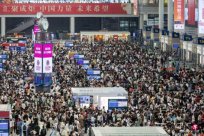(Beijing Comprehensive News) The latest PMI data of Caixin shows that the prosperity of the Chinese manufacturing and service industry continues to expand, but the speed has slowed down and the economic recovery momentum is still unstable.
Caixin.com Monday (October 1) announced that September Caixin China Manufacturing Purchasing Manager Index (PMI) was 50.6, a decrease of 0.4 percentage points from August. It was the fourth time in the past five months.At the top of the withered line, the prosperity of the manufacturing industry continues to maintain a slow recovery trend.
September Caixin China ’s service industry PMI decreased by 1.6 percentage points to 50.2. Although this is the ninth consecutive month of the service industry, it has remained in the expansion range, it has already reached a new year low in the second consecutive month, showing that the service industry activities have grown growth.The speed is losing power.
The day before, the China National Bureau of Statistics showed that the official manufacturing PMI rose to 50.2 in September, a rising for four consecutive months, the first time since April to the expansion range.The official non -manufacturing PMI rose to 51.7, reversing the previous five consecutive months of decline, showing that the expansion of non -manufacturing industry has increased.
September Caixin PMI data trend is not consistent with the National Bureau of Statistics PMI.Compared with the official PMI, Caixin data mainly covers companies with smaller scale and export -oriented.
Bloomberg economist Zhu Xi said that the slowdown of Caixin's data shows that private enterprises and exporters still face heavy pressure, and some companies, especially private enterprises, are still cautious about recruitment.
Wang Yan, a senior economist of Caixin Think Tank, said that in the past few months, many official policies have been introduced in the past few months, and various important economic indicators have improved marginal improvements and macroeconomics have shown signs of stability.The demand is still insufficient, there are still many external uncertain factors, and the pressure on the employment market is still high.
Caixin.com pointed out that high -frequency data shows that the disposal of real estate and local debt risks is still the key to affecting the vitality restoration of China's economy.
According to the Bloomberg September survey, due to the continuous crisis in the real estate sector, economists have lowered their expectations for China's economic growth, and this year's economic growth may have just reached about 5%.
China official last Thursday (September 28) said at the National Day enrollment that it is necessary to effectively prevent and resolve major risks and strive to achieve the annual economic and social development goals.The People's Bank of China stated last Wednesday (September 27) that the current external environment is more complicated and severe. It will "accurately and powerful" implement a stable monetary policy, and strive to expand domestic demand and boost confidence.


